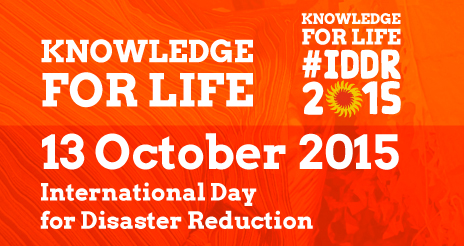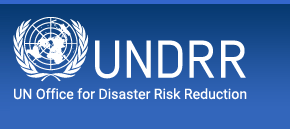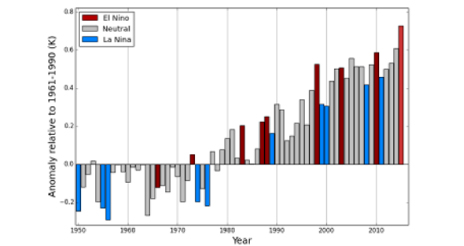- Our Mandate
- Mission and Objectives
- UNDRR in the UN
- Work Programme & Annual Reports
- Results Based System
- Work Partnerships
- Headquarters - Geneva
- SG-UN representatives for DRR
- Regional Office – The Americas and the Caribbean
- Head of the Regional Office – The Americas and the Caribbean
- What is Disaster Risk Reduction?
- What is the International Strategy?
- History of UNDRR
Americas hit hard by El Niño
By: UNDRR
PANAMA CITY, November 27, 2015 - The Americas are paying a high price as one of the worst El Niños on record continues to strengthen. The World Meteorological Organization this week singled out “considerable concern” about the impact of El Niño on the Amazon basin in the context of long-term climate change.
In a year which is also expected to be declared the hottest on record, significant warming has been recorded in western North America and large areas of South America. The Tropical Pacific which gives birth to the El Niño phenomenon, has been much warmer than average this year, exceeding 1°C over much of the central and eastern equatorial Pacific, consistent with the signature of a strong El Niño.
WMO stated “the unusually prolonged, intense and hot dry seasons in the Amazon basin of Brazil in both 2014 and 2015 which, while they cannot yet be stated with confidence to be part of a long-term trend, are of considerable concern in the context of potential ‘tipping points’ in the climate system as identified by the Intergovernmental Panel on Climate Change.”
Large areas of Central America and the Caribbean have recorded below average rainfall this year. The drought in Brazil shifted north from southern and eastern areas. Yet heavy rain and flooding also affected parts of the region including Argentina, Guatemala and Peru.
In October, as many as 500 people lost their lives when torrential rain triggered mudslides in Santa Catarian Pinula on the outskirts of Guatemala City, burying over 100 homes under rock, earth and trees. Warnings not to build in the area were ignored.
Areas of high rainfall this year have included: southern areas of the USA, Mexico, Bolivia, and southern Brazil. March’s heavy rains in Chile caused flooding and mudslides. In August, heavy rain in the Buenos Aires province of Argentina saw several monthly and daily rainfall records broken during the month.
Mexico had its wettest March on record since 1941. It was the wettest May on record for the contiguous USA and the wettest month overall in 121 years of record keeping.
Peru and Ecuador where the term El Niño originated – warmer ocean surface temperature that was first noticed in 1950 by fishermen in the region before Christmas - were the first to take action.
Peru’s national government has declared a state of emergency in 14 of the country’s departments / regions and set aside a budget of US$1bn to prepare two million people who are particularly vulnerable to mudslides and flooding. According to the Ministry of Economy and Finance (MEF), regional governments of Peru have already invested over US$52 million USD in resilience and assigned 6% of their total budget for projects to mitigate El Niño impacts.
Peru and its economy are particularly vulnerable to El Niño. The 1997–1998 event caused deadly flooding and mudslides, and the government calculated that damage to infrastructure amounted to about USD 3.5 billion, or about 4.5% of GDP.
Ecuador which has not yet declared a state of emergency has also taken a number of measures to deal with the event elaborating maps of areas vulnerable to flooding, assessing its weather forecast every two weeks and putting in place a number of programmes to assist the vulnerable agricultural sector.
Colombia has set up a national committee led by the UNGRD (the National Agency for Disaster Risk Management), implementing a national contingency plan and sectoral plans as well as assigning a budget.
The governor of Chuquisaca province in Bolivia, Esteban Urquizu, has declared a state of emergency following heavy rains and hailstorms triggered by El Nino. Rains, hailstorms, drought, frost and floods also caused damage in the departments of Cochabamba and Potosí. In the town of Arani, Cochabamba, at least 250 families are affected by hailstorms, Mayor Rolando Torrico said.
In Potosi, the director of Risk Management Department, Fernando Elias, he reported that there are 398 affected families in the northern region by the floods. There are also 14 communities affected by the hail. The affected area is 27 hectares and the percentage of frost and hail loss reaches 63%.
The current weather phenomenon El Niño is one of the most virulent since 1950 and should be strengthened through year-end, causing, by region, floods and droughts, the WMO warns.
Bolivia has also adopted a national emergency plan and assigned over US$6.5 million to contingency plans. Subnational and municipal governments are asked now to develop their own contingency plans.
If most countries are investing in disaster risk reduction measures, some have been less pro-active in anticipating the impacts.
TV Globo's daily news programme Bom Dia Brasil highlighted recently that Brazil had invested 45% less in disaster risk reduction measures so far in 2015 compared to 2014 which was already less than in 2013.
Related link
Follow the UNDRR news online:
 International Day for Disaster Reduction #DIRD 2015 Knowledge for Life
International Day for Disaster Reduction #DIRD 2015 Knowledge for Life
More information

 Global annual average temperatures anomalies (relative to 1961-1990) based on an average of three global temperature data sets (HadCRUT.4.4.0.0, GISTEMP and NOAAGlobalTemp) from 1950 to 2014. The 2015 average is based on data from January to October. Bars are coloured according to whether the year was classified as an El Niño year (red), a La Niña year (blue) or an ENSO-neutral year (grey). Note uncertainty ranges are not shown, but are around 0.1°C (Credit: WMO)
Global annual average temperatures anomalies (relative to 1961-1990) based on an average of three global temperature data sets (HadCRUT.4.4.0.0, GISTEMP and NOAAGlobalTemp) from 1950 to 2014. The 2015 average is based on data from January to October. Bars are coloured according to whether the year was classified as an El Niño year (red), a La Niña year (blue) or an ENSO-neutral year (grey). Note uncertainty ranges are not shown, but are around 0.1°C (Credit: WMO)